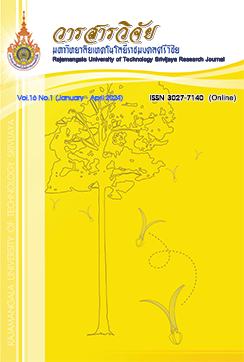Sorption Isotherm and Quality Changes during Storage of Snack from Green Mussel and Hom-Kradang-Nga Rice
Keywords:
Sorption isotherms, quality change, snackAbstract
Sorption isotherms of mussel and Hom-kradang-nga rice snacks were determined at 35 °C and 45 °C with a controlled humidity system using a saturated salt solution with aw ranging from 0.2 to 0.9. It was found that the equilibrium humidity of the product increased as the aw value increased at constant temperature. The characteristic shapes of the curve plotted between moisture content and aw values of snack were sigmoid. GAB mathematical models highly correlated with the experimental data of the equilibrium moisture content of products at 35°C and 45 °C. The SEE values were 1.10 and 1.13, respectively, and the R2 value was 0.99. Additionally, L* color and hardness values decreased during the 4-week storage at room temperature (p<0.05). While moisture content and aw tended to rise (p<0.05), a* and b* color values were not significantly different (p>0.05). Furthermore, the product was safe for consumption because the total microbial count was less than 1x106 cfu/g. The yeast and mold content did not exceed 100 cfu/g. The snack product received an overall liking score in the range of 6.70- 7.10 (out of 9) indicating a slightly moderate liking.
References
AOAC. 1995. Official methods of analysis. 16th ed. Association of official analytical chemists. Washington DC, USA.
Aviara, N.A. 2020. Moisture sorption isotherms and isotherm model performance evaluation for food and agricultural products, pp. 1-33. In Kyzas, G and Lararidis, N., eds. Sorption in 2020s. Intech Open, London.
Bacteriological Analytical Manual (BAM). 2003. Food Sampling/Preparation of sample Homogenate Chapter 1. Available Source: https://www.fda.gov/food/laboratory-methods-food/bam-chapter-1-food-samplingpreparation-sample-homogenate, June 2, 2019.
Bianco, A.M., Pollio, M.L., Resnik, S.L., Boente, G. and Larumbe, A. 1997. Comparison of water sorption behavior of three rice varieties under different temperatures. Journal of Food Engineering 33: 395-403.
Cauvian, S.P. and Young., L.S. 2000. Bakery Food Manufacturing and Quality: Water Control and Effects. Blackwell Science Ltd., Oxford.
Chinnasarn, S., Yuenyongputtakal, W. and Chinnasarn, K. 2012. Research Report on Development of healthy snack from surimi and job’s tears flour. NRU & HERP, Bangkok. (in Thai)
Coastal Aquaculture Research and Development Division. 2004. Smart Farmer: Clam Cultivation. Department of Fisheries, Bangkok. (in Thai)
Farahnaky, A., Ansari, S. and Majzoobi, M. 2009. Effect of glycerol on the moisture sorption isotherms of figs. Journal of Food Engineering 93: 468-473.
Flexifoil Packaging PVT Ltd. 2012. Barrier Properties of Films. Available Source: http://www.flexifoilpackaging.com/barrier-properties-films, July 21, 2020.
Food Intelligence Center. 2021. Snacks Product Trend. Market Intelligence. Available Source: http://fic.nfi.or.th/MarketOverview DomesticDetail. php?id=354, March 11, 2020. (in Thai)
Kaewnango, E., Saeng-arun, N., Suwanno, S., Thongchai, A., Saeton, S., Panichkij, S., Posiri, W., Dantaweesin, W., Chotechuen, S., Cheaupun, K., Wongpiyachon, S., Akkaravessapong, P., Pantuwan, G., Nookong, B., Srisuwan, C., Plodplong, K. and Moo-na, M. 2014. PTNC09002-59 : Hawm Gra Dang Ngah Narathiwat New Native Landrace Rice, pp.105-117. In Proceedings of the 31st Rice and Temperate Cereal Crops Annual Conference. Division of Rice Research and Development, Bangkok. (in Thai)
Lucas, B.F., de Morais, M.G., Santos, T.D., Jorge Alberto, J. and Costa, V. 2018. Spirulina for snack enrichment: Nutritional, physical and sensory evaluations. LWT- Food Science and Technology 90 (1): 270-276.
Mathlouthi, M. 2001. Water content, water activity, water structure and the stability of foodstuffs. Food Control. 12(7): 409-417.
Mohamed, L.A., Kouhila, M., Jamali, A., Lahsasni, S. and Mahrouz, M. 2004. Moisture sorption isotherms and heat of sorption of bitter orange leaves (Citrus aurantium). Journal of Food Engineering 67(4): 491-498.
Nursten, H. 2005. The Maillard Reaction. The Royal Society of Chemistry, Cambridge.
Pannarunothai, R. 2000. The role of water activity in the food industry. Charpa Journal 56(7): 57-61. (in Thai)
Sorapukdee, S., Uesakulrungrueng, C. and Pilasombut, K. 2016. Effects of humectant and roasting on physicochemical and sensory properties of jerky made from spent hen meat. Korean Journal for Food Science of Animal Resources 36(3): 326-334.
Thai Community Product Standard. 2019. Seasoning Crispy Rice: 10501/2562. Ministry of Industrial, Bangkok. (in Thai)
Thalerngnawachart, S. and Duangmal, K. 2014. Moisture sorption isotherms of osmosed-air dried fruits. KKU Science Journal 42(1): 25-37. (in Thai)
Wani, S.A. and Kumar, P. 2006. Moisture sorption isotherms and evaluation of quality changes in extruded snacks during storage. LWT-Food Science and Technology 74 (1): 448-455.
Downloads
Published
How to Cite
Issue
Section
License
Copyright (c) 2024 Rajamangala University of Technology Srivijaya Research Journal

This work is licensed under a Creative Commons Attribution-NonCommercial-NoDerivatives 4.0 International License.
The content and information in the article published in Journal of Rajamangala University of Technology Srivijaya It is the opinion and responsibility of the author of the article. The editorial journals do not need to agree. Or share any responsibility.







